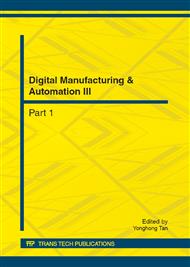p.164
p.168
p.173
p.177
p.182
p.187
p.191
p.195
p.199
Simulation and Modeling Method for Micro Turn-Milling Cutting Process
Abstract:
A simulation and modeling method for micro turn-milling cutting process was investigated to predict the impacts of cutting speed and cutting depth on cutting force. Based on material Johnson-Cook constitutive model and chip separation criteria, the finite element model was established in ABAQUS simulation application, then the model analysis and experiment verification was conducted. The results indicate that the simulation model can predict the value and regularity of cutting force, which can provide guidance on process optimization and machining accuracy control.
Info:
Periodical:
Pages:
182-186
Citation:
Online since:
July 2012
Authors:
Price:
Сopyright:
© 2012 Trans Tech Publications Ltd. All Rights Reserved
Share:
Citation:


